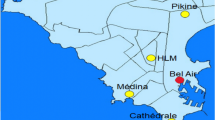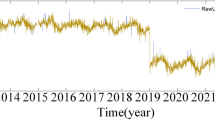Abstract
Both canonical correlation analysis (CCA) and principal component analysis (PCA) were applied to atmospheric aerosol and trace gas concentrations and meteorological data collected in Chicago during the summer months of 2002, 2003, and 2004. Concentrations of ammonium, calcium, nitrate, sulfate, and oxalate particulate matter, as well as, meteorological parameters temperature, wind speed, wind direction, and humidity were subjected to CCA and PCA. Ozone and nitrogen oxide mixing ratios were also included in the data set. The purpose of statistical analysis was to determine the extent of existing linear relationship(s), or lack thereof, between meteorological parameters and pollutant concentrations in addition to reducing dimensionality of the original data to determine sources of pollutants. In CCA, the first three canonical variate pairs derived were statistically significant at the 0.05 level. Canonical correlation between the first canonical variate pair was 0.821, while correlations of the second and third canonical variate pairs were 0.562 and 0.461, respectively. The first canonical variate pair indicated that increasing temperatures resulted in high ozone mixing ratios, while the second canonical variate pair showed wind speed and humidity’s influence on local ammonium concentrations. No new information was uncovered in the third variate pair. Canonical loadings were also interpreted for information regarding relationships between data sets. Four principal components (PCs), expressing 77.0 % of original data variance, were derived in PCA. Interpretation of PCs suggested significant production and/or transport of secondary aerosols in the region (PC1). Furthermore, photochemical production of ozone and wind speed’s influence on pollutants were expressed (PC2) along with overall measure of local meteorology (PC3). In summary, CCA and PCA results combined were successful in uncovering linear relationships between meteorology and air pollutants in Chicago and aided in determining possible pollutant sources.




Similar content being viewed by others
References
Almeida, S. M., Pio, C. A., Freitas, M. C., Reis, M. A., & Trancoso, M. A. (2006). Source apportionment of atmospheric urban aerosol based on weekdays/weekend variability: evaluation of road re-suspended dust contribution. Atmospheric Environment, 40, 2058–2067.
Bascom, R., Bromberg, P. A., Costa, D. A., Devlin, R., Dockery, D. W., Frampton, M. W., et al. (1996). Health effects of outdoor air pollution. American Journal of Respiratory and Critical Care Medicine, 153, 3–50.
Braga, C. F., Teixeira, E. C., Meira, L., Wiegand, F., Yoneama, M. L., & Dias, J. F. (2005). Elemental composition of PM10 and PM2.5 in urban environment in South Brazil. Atmospheric Environment, 39, 1801–1815.
Day, D. A., Liu, S., Russel, L. M., & Ziemann, P. J. (2010). Organonitrate group concentrations in submicron particles with high nitrate and organic fractions in coastal southern California. Atmospheric Environment, 44, 1970–1979.
Du, H., Kong, L., Cheng, T., Chen, J., Yang, X., Zhang, R., et al. (2010). Insights into ammonium particle-to-gas conversion: non-sulfate ammonium coupling with nitrate and chloride. Aerosol and Air Quality Research, 10, 589–595.
Finlayson-Pitts, B. J., & Pitts, J. N., Jr. (2000). Chemistry of the upper and lower atmosphere. New York: Academic.
Fosco, T., & Schmeling, M. (2007). Determination of water-soluble atmospheric aerosols using ion chromatography. Environmental Monitoring and Assessment, 130, 187–199.
Fosco, T., & Schmeling, M. (2006). Aerosol ion concentration dependence on atmospheric conditions in Chicago. Atmospheric Environment, 40, 6638–6649.
Garnes, L. A., & Allen, D. T. (2002). Size distribution of organonitrates in ambient aerosol collected in Houston, Texas. Aerosol Science and Technology, 36, 983–992.
Google (2012). Google maps. maps.google.com. Accessed February 29, 2012.
Hair, J. F., Jr., Anderson, R. E., Tatham, R. L., & Black, W. C. (1992). Canonical correlation analysis. In Multivariate data analysis with readings (pp. 193–222). New York: Macmillan Publishing Company.
Harrison, R. M., Smith, D. J. T., & Luhana, L. (1996). Source apportionment of atmospheric polycyclic aromatic hydrocarbons collected from an urban location in Birmingham, U.K. Environmental Science and Technology, 30, 825–832.
Hsieh, L.-Y., Chen, C.-L., Wan, M.-W., Tsai, C.-H., & Tsai, Y. I. (2008). Speciation and temporal characterization of dicarboxylic acids in PM2.5 during a PM episode and a period of non-episodic pollution. Atmospheric Environment, 42, 6836–6850.
Johnson, R. A., & Wichern, D. W. (1998). Canonical correlation analysis. In Applied multivariate statistical analysis (pp. 587–627). Upper Saddle River: Prentice Hall.
Lee, J. H., & Hopke, P. K. (2006). Apportioning sources of PM2.5 in St. Louis, MO using speciation trends network data. Atmospheric Environment, 40, S360–S377.
Lee, H. S., Wadden, R. A., & Scheff, P. A. (1993). Measurements and evaluation of acid air pollutants in Chicago using an annular denuder system. Atmospheric Environment, 27A, 543–553.
Liu, S., Shilling, J. E., Song, C., Hiranuma, N., Zaveri, R. A., & Russell, L. M. (2012). Hydrolysis of organonitrate functional groups in aerosol particles. Aerosol Science and Technology, 46, 1359–1369.
Manly, B. F. J. (2005). Canonical correlation analysis. In Multivariate statistical methods: a primer (pp. 143–161). New York: Chapman and; Hall/CRC.
Minitab Inc. (2010). Minitab 16 Statistical Software [Computer Software]. State College, PA.
Ravindra, K., Stranger, M., & Van Grieken, R. (2008). Chemical characterization and multivariate analysis of atmospheric PM2.5 particles. Journal of Atmospheric Chemistry, 59, 199–218.
SAS Institute Inc. (2010). SAS 9.2 Statistical Software [Computer Software]. Cary, NC.
Scheff, P. A., Wadden, R. A., & Allen, R. J. (1984). Quantitative assessment of Chicago air pollution through analysis of covariance. Atmospheric Environment, 18, 1623–1631.
Schlesinger, R. B. (2007). The health impact of common inorganic components of fine particulate matter (PM2.5) in ambient air: a critical review. Inhalation Toxicology, 19, 811–832.
Seinfeld, J. H., & Pandis, S. N. (1998). Atmospheric chemistry and physics: from air pollution to climate change. New York: Wiley.
Shen, Z., Cao, J., Arimoto, R., Han, Z., Zhang, R., Han, Y., et al. (2009). Ionic composition of TSP and PM2.5 during dust storms and air pollution episodes at Xi’an, China. Atmospheric Environment, 43, 2911–2918.
Simcik, M. F., Eisenreich, S. J., & Lioy, P. J. (1999). Source apportionment and source/sink relationships of PAHs in the coastal atmosphere of Chicago and Lake Michigan. Atmospheric Environment, 33, 5071–5079.
Statheropoulos, M., Vassiliadis, N., & Pappa, A. (1998). Principal component and canonical correlation analysis for examining air pollution and meteorological data. Atmospheric Environment, 32, 1087–1095.
U.S. Census Bureau. (2010). 2010 Census interactive population search. http://2010.census.gov/2010census/popmap/ipmtext.php?fl=17. Accessed June 11, 2012.
U.S. Environmental Protection Agency. (2010). Our Nation’s air: status and trends through 2008. http://www.epa.gov/airtrends/2010/report/fullreport.pdf. Accessed December 13, 2012.
Wilks, D. S. (2011). Principal component (EOF) analysis. In Statistical methods in the atmospheric sciences (pp. 519–562). New York: Elsevier Inc.
Yu, T. Y., & Chang, I. C. (2006). Spatiotemporal features of severe air pollution in northern Taiwan. Environmental Science and Pollution Research, 13, 268–275.
Zhou, F., Guo, H., & Liu, L. (2007). Quantitative identification and source apportionment of anthropogenic heavy metals in marine sediment of Hong Kong. Environmental Geology, 53, 295–305.
Acknowledgments
The authors gratefully acknowledge and thank Sophonie Tchoua for his assistance with SAS® 9.2 software programming and coding in applying CCA to the dataset.
Author information
Authors and Affiliations
Corresponding author
Rights and permissions
About this article
Cite this article
Binaku, K., O’Brien, T., Schmeling, M. et al. Statistical analysis of aerosol species, trace gasses, and meteorology in Chicago. Environ Monit Assess 185, 7295–7308 (2013). https://doi.org/10.1007/s10661-013-3101-y
Received:
Accepted:
Published:
Issue Date:
DOI: https://doi.org/10.1007/s10661-013-3101-y




